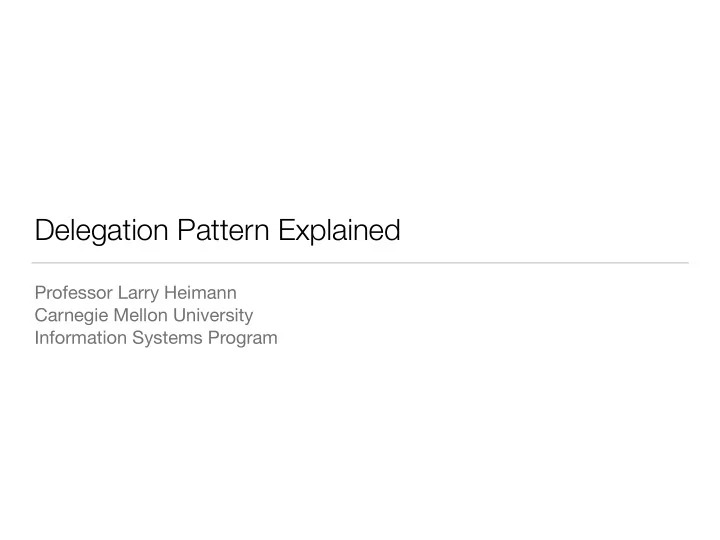

Delegation Pattern Explained Professor Larry Heimann Carnegie Mellon University Information Systems Program
An example close to home…
How does Grader calculate grades? Option 1: if / else if / else if course == “67272” ... else if course == “67327” ... else if course == “67327” ... else if course == “67344” ... else if course == “67373” ... else if course == “67442” ... else if course == “67475” ... else ...
How does Grader calculate grades? Option 1: if / else if / else if course == “67272” ... else if course == “67327” ... else if course == “67327” ... else if course == “67344” Problems ... else if course == “67373” • length quickly grows ... else if course == “67442” • complexity high ... • constantly needs to else if course == “67475” ... be updated else ...
How does Grader calculate grades? Option 2: use closures calculate_grades(){ 67272_closure } calculate_grades(){ 67327_closure } calculate_grades(){ 67344_closure } calculate_grades(){ 67442_closure }
How does Grader calculate grades? Option 2: use closures calculate_grades(){ 67272_closure } calculate_grades(){ 67327_closure } calculate_grades(){ 67344_closure } Issues calculate_grades(){ 67442_closure } • overall much better! • blocks can still be long, error-prone • managing multiple blocks
How does Grader calculate grades? Option 3: rely on delegation
How does Grader calculate grades? Option 3: rely on delegation
What does it generally take to delegate? Step 1: establish a ‘contract’ defining the delegate’s responsibility. Step 2: establish two-way channels of communication between delegate and constituent. Step 3: constituent uses channels to inform delegate of important changes; delegate responds.
Delegate pattern in iOS (5 easy steps) Five steps for setting up the delegate pattern between two objects, where object B is the delegate for object A, and object A will send out the messages: 1. Define a delegate protocol for object A; consider protocol extensions as appropriate. 2. Make object B conform to the delegate protocol. It should put the name of the protocol in its class line and implement the methods from the protocol. 3. Give object A an optional delegate variable. ( This variable should be weak. ) 4. Tell object A that object B is now its delegate. 5. Make object A send messages to its delegate when something interesting happens, such as the user pressing the Cancel or Done buttons, or when it needs a piece of information.
Simple Delegation Example
Recommend
More recommend